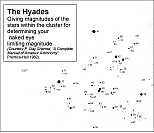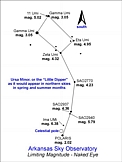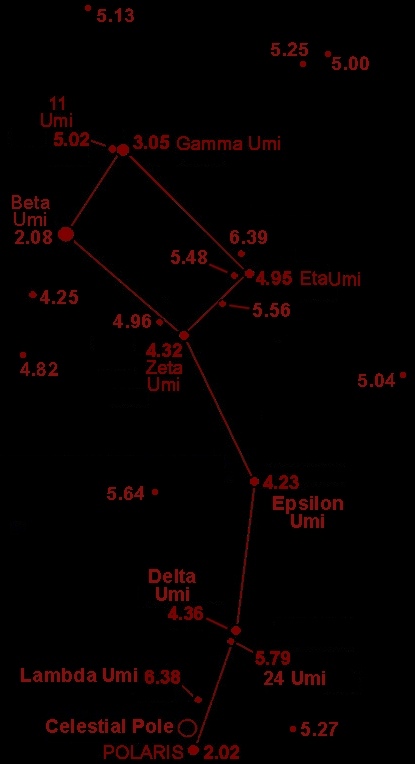SEEING CONDITIONS AND TRANSPARENCY
![]()
Last updated: 30 September 2007
|
SEEING CONDITIONS AND TRANSPARENCY |
SEEING CONDITIONS AND TRANSPARENCY: You be the Judge of the Night Sky!
Every time winter rolls in frosty nights our way, questions surface and telescope performance concerns arise. Under these crisp, clear winter skies of North America, the stars almost reach out and grab us as they twinkle against the inky background of distant space.
"Why can't I make out Cassini's division at 75 power?....I used to do it all the time. I'm worried about my telescope!"
"I looked at Jupiter and could see the four moons [Galilean satellites] but for some reason all I could see was two brown bands! It was all washed out. What's wrong with my ETX?"
"While looking at Betelgeuse last night I could see the nice red color okay, but now I'm really sick. I think something's happened to my scope! Coming straight up (it was nearly overhead) I could see a bright flare of light, making the star look elongated. Should I send the telescope back?"
Do these sound familiar? And to make it worse, these actual concerns were sent to me from people who spent a night in the freezing cold to "enjoy" the wonderful hobby of amateur astronomy.
In every case, EVERY telescope (and the dozens of others from users this winter) was just fine! It just so happens that, from where they were observing the sky was TOO CLEAR. Those "twinkling stars?" THEY are to blame (or at least what you SEE of them); read on....
"Too Clear?!" You say. There's no such thing. Yep, there is for high power viewing and maximum resolution. And it usually happens in winter.
The term "too clear" refers astronomically to really good "sky transparency," our ability to peer through our own atmosphere filled with water vapor, gases, pollution, dust and even light toward the dark of space. Without the atmosphere, every night would be perfect, even when the moon was out!
The term "steady image" , known as "seeing" astronomically, is totally unrelated and - indeed -can be thought of as "inversely proportional" to the "transparency." Simply put....the BETTER the transparency (like in winter months) the WORSE the "seeing" or image steadiness is typically.
Imagine it this way: "transparency" relates to how DEEP you can see in space through the obstacle of the earth's air. The better the transparency, the fainter the object or star that you might be able to see.
On the other hand, "seeing" has absolutely NOTHING to do with transparency; it is a gauge of how PERFECT, or steady, the image remains while you view it.
Now before going into detail, remember the "really-neat-rule:"
1) If the night is perfectly transparent, it is a low power night, but not necessarily a high power night;
2) If the night is perfectly steady, it is a high power night, but not necessarily a low power night;
3) If the night is transparent AND steady at the same time, it is a PERFECT night, both for low- and high-power viewing;
4) If the night is cloudy, it's Miller time.
SKY TRANSPARENCY AND WHAT TO EXPECT
In the old days when I was an astronomer, sky "transparency" was judged both visually and photoelectrically by a scale of 1 to 6.6, with 6.6 (the hypothetical limiting magnitude of the faintest star visible to the eye before light pollution) being perfectly deep clear. On the other hand "1" would represent ONLY the brightest planets and stars (magnitude "1" or brighter) being visible. Such a case would be in the summer months when smog or fog "capped" the night air preventing all but the brightest objects from being seen. As we will see, such nights are the very BEST for "steadiness!"
Here are two charts (one that has appeared on this web site previously, but it is worth using again). Click onto the charts and each will print out a large quality print for you to use outdoors; slip them into a sheet protector or laminate and it will allow you to judge your transparency from any location on the Transparency Scale. The Hyades is excellent for fall, winter and early spring, and the "little dipper (Ursa Minor) is excellent for Spring, Summer and Fall since it is circumpolar (mid-northern latitudes) and can be seen nearly all night; however, it should (like the Hyades cluster) be used as a guide ONLY when the stars are reasonably high in the sky.


In transparency - and particularly for astronomy - there is a factor knows as "atmospheric extinction" which causes starlight to diminish as the object decreases in altitude toward any horizon. It is caused by the "stuff" in our air, and particularly troublesome during high humidity and smoggy conditions.
As I mentioned, "transparency" is a measure of how clear the sky is; this will allow you to see fainter stars and deep sky objects, but will NOT necessarily allow you to use more than about 25x per inch aperture, and then only for deep sky objects. Typically speaking (there are exceptions) the CLEAREST NIGHTS are the most UNSTEADY.
This is because of meteorology, not astronomy. All day long, whether cloudy or raining or snowing, the earth's crust and all upon it soak up the radiation from the sun in wavelengths that we cannot even see. Objects on the ground will HOLD that energy so long as: 1) the air around them is near the same temperature as the heat-soaked objects; or/and, 2) the object continues to receive an equal amount of radiation (heat) that it is losing into the air over the same period of time.
Okay, what happens at NIGHT? Same thing that happens in the desert on a hot summer day when your are driving down Route 66 at mid-afternoon: the GROUND is much warmer than the surrounding air and heat (the ground) always dissipates into cold (the air). When on the desert highway, we see this as a wavy image (mirage) as if water was standing on the road in the distance. At night, we see this rapidly rising air as "twinkling stars."
This nighttime convection is called attaining THERMAL EQUILIBRIUM (I won't use terms like that anymore) and continues until the ground is the exact SAME temperature as the air.
This condition (happens every night to a degree) DOES NOT affect transparency, although it is the most detrimental factor involving "seeing."
So, the first thing you will do each night you go out is to judge the "transparency" by seeing which of the stars you can distinguish from the charts. It is fun and interesting to keep track; for example, in Arkansas the month of OCTOBER is by far the best combination of "transparency" and "seeing" of any month, and also just happens to be the most weather-friendly month as well!
Transparency is usually worse in summer (inversion layers of air, stagnation of air) and best in winter (cold blast of artic air bring pure, arctic-filtered and clean air southward).
Once you have checked out how clear the sky is, let's move on to see if you can make out the Great Red Spot or the Polar Region of Saturn with some really cool high power.
ATMOSPHERIC SEEING CONDITIONS
We have seen that really clear skies don't normally indicated that the night is also a really good night for high power planetary work or splitting that double star you've been promising to do but keep putting off. Also, we understand now that it is the EARTH that is responsible ("....baaaad Earth!") for giving us nights when we THINK we should be able to see Cassini's division on Saturn ("...but I saw it last night!") but it is invisible except in fleeting glimpses.
Seeing can be rated on a scale of "1" to "5", with "1" good only for lowest power viewing and "5" perfect steadiness. Remember that I said that in summer stagnation and "inversion layers" cap our atmosphere to prevent really "transparent" nights? This is GOOD for seeing....because the air below the inversion is trapped, the heat cannot move rapidly in these upward currents. Consequently, the air immediately above your telescope is very, very "steady."
Early at night is the worst time for steadiness; just as soon as the sun sinks low enough in the sky, the ground begins "giving up" the heat it has basked in all day long. Those heat currents rise rapidly upward into the sky. Let's look at how we see them:
1) NAKED EYE - you can use the twinkling of stars to get a quick handle on the night's seeing conditions, using an imaginary scale. Look toward your most unobscured horizon (where you can see stars closest to the distant horizon) and mentally divide the sky into four (4) equal parts from that horizon to overhead. Each one of those "parts" we'll call a ZONE for seeing evaluation. "Zone 4" is from the horizon to 1/4 way up to the Zenith (directly overhead); by comparison,. "Zone 1" IS overhead. Now look at the brightest stars in each of your quadrants starting with the horizon; are stars in Zone 1 twinkling? how about Zone 3, a little above the first zone....are those stars also twinkling? Now Zone 2, nearly overhead...
Now it's easy: if ONLY the stars in Zone 4 (lowest to the horizon) are twinkling rapidly then your "seeing" is AT LEAST a "4" on a perfect scale of "5"; if however a bit higher up in Zone 3 the stars are ALSO twinkling like those in Zone 4, your seeing is NOW "3"; if the stars are twinkling rapidly all the way to the Zenith (Zone 1, then your seeing is a pitiful "1", the worst it can be).
Remember...this has NOTHING to do with the "transparency" of the sky!
If, on the other hand, NONE of the stars twinkle all the way to the horizon, then your "seeing" is possibly a "5." To determine whether it is that good requires that you move from your naked eye to the telescope!
2) TELESCOPIC SEEING - so far we have determined that you might have a really "steady" night of at least "4" and perhaps a perfect "5." Let's check: turn your telescope to a very bright star that is close to overhead. Make sure to center precisely in your field of view. Check you air steadiness through two steps:
1) focus precisely the star until the image (the "Airy disk") is as small as possible; the smaller the telescope, the LARGER the center bright "point", or Airy disk, will be. Once focused, you should begin to see clear "diffraction rings" surround the Airy disk that appear to be thin rings of light; if you are using a Newtonian telescope, you will see four spike-like streaks of light from the secondary mirror holder. Under steady conditions you will note that a) the Airy disk does NOT MOVE nor does it change size; and b) the concentric rings remain fairly steady, both in motion and brightness. You should see perhaps three rings in most telescopes, perhaps more.
2) now the tough test. Put the same star out-fo-focus until you see a medium-sized disk (not too big) of light with a center dark portion, looking much like a donut and its hole in the center. Put this de-focused star in the dead center of your FOV; well collimated optics will show the dark spot exactly centered on the bright disk. If your star moves toward any edge of your FOV, the dark disk will shift in the OPPOSITE direction! So keep centered. Once de-focused, look carefully at the bright disk. You will see alternating rings of dark and light, very, very fine. Examine all of them and see if they appear to move, or oscillation. If the image moves like a squirmy amoeba, then your seeing is terrible and you can forget high power. It's galaxy viewing tonight. On the other hand, if the image is very steady and uniformly bright your seeing can be excellent!
It's really simple to evaluate. Always remember: there ARE going to be nights when you want to give up and blame the telescope for poor performance when you might not have the contrast or detail you are used to seeing. Indeed, it is probably the "seeing conditions," and not your scope. If you find yourself in this situation "...take that lemon and make lemonaide!" as they say. Develop a mindset that "...tonight, I'm going to find those galaxies that I have been looking for!"
A CLOSING WORD OF CAUTION!! The best "seeing" and the deepest "transparency" cannot offset a telescope that is suddenly rushed out of the house and plunged into the cool (or cold) night air. Here is the rule of thumb that we have always used, no matter HOW BIG or SMALL the telescope: put the scope in the observing location (in shade if the sun is still shining) for a TOTAL of 20 MINUTES PER INCH of aperture of telescope. A three-inch needs ONE HOUR to adjust (thermal equilibrium - heck, I did it again!), while a five-inch requires TWO HOURS. But the wait is worth it.
This is why professional observatories (even with forced ventilation systems) open the domes at before sunset and commence through dusk to allow the scope to equalize with the night air. The longer the night goes on, the more "married" are the temperatures of your telescope and the air around it.
Now that you understand all of this (isn't it interesting that most of this has absolutely NOTHING to do with your telescope itself?), you can probably have a better grasp of why the scope that you love so much sometimes can be ornery as a pet cat, tuned to your beckoning call one minute, only to ignore your very existence the next!
Here's to the best in "seeing" for all of you....
P. Clay Sherrod
Arkansas Sky Observatory
conway / Petit Jean Mountain
Arkansas
Subject: An error on your "Seeing" web pageSent: Wednesday, September 26, 2007 00:38:09 From: RockyABQ@aol.com (RockyABQ@aol.com) Dear Clay and/or Mike, One of your pages online regarding "Seeing" (http://www.weasner.com/etx/buyer-newuser-tips/seeing.html) has an error in one of the charts. The chart depicting the "Little Dipper", Umi, has Beta Umi (2.08m) listed as a duplicate Gamma. I adapted the attached chart to include some additional surrounding stars. It's a combination of your chart and additional stars and their magnitudes from Sky-Map.org and with a black background and dark red data. I can view it on my pocket PC without killing my night vision. Feel free to use it on your site if you like. Also, thanks for all the great information. Take care, Rocky (Albuquerque, NM)

And:
From: P. Clay Sherrod (drclay@tcworks.net) I am traveling at this time and cannot check this; I suspect that you may be correct on this because the error of Gamma exists on several major older star catalog/charts from the 20th century. Thanks for pointing this out. Dr. Clay ------------- Arkansas Sky Observatories Harvard MPC/ H43 (Conway) Harvard MPC/ H41 (Petit Jean Mountain) Harvard MPC/ H45 (Petit Jean Mtn. South) http://www.arksky.org/
Return to the top of this page.
Go back to the Observational Guides & References page.
Go back to my ETX Home Page.